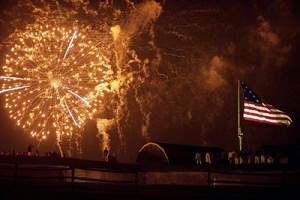Old Glory shines brighter thanks to solar
 It was Flag Day yesterday (June 14), and the folks over at Fort McHenry in Baltimore were smiling under a giant U.S. flag illumined at night by solar panels. It’s the first Flag Day that the system’s been operational.
It was Flag Day yesterday (June 14), and the folks over at Fort McHenry in Baltimore were smiling under a giant U.S. flag illumined at night by solar panels. It’s the first Flag Day that the system’s been operational.
Given that Francis Scott Key penned “The Star Spangled Banner” while imprisoned by the British during the War of 1812 and looking at the flag at Fort McHenry, it might just be one of the most important flags flying.
Previously the gigantic, 30-foot-by-42-foot flag was lit by large conventional spotlights that took away from the historical nature of the site, said John Holtzinger, project manager with the National Park Service (NPS) at the Fort McHenry National Monument & Historic Shrine.
“The old spotlights were really big and looked kind of out of place,” he said.
But now, Ft. McHenry’s Old Glory is lit thanks to four photovoltaic panels from Solar Electric Power Co. (SEPCO) and LED floodlights from Beacon, according to Holtzinger. Whereas the previous floodlights were roughly the size of a trashcan, the new lights are smaller than a trashcan, he said.
The solar arrays are tied to batteries and light detectors, so the floodlights don’t work during the daytime but come on automatically as dusk approaches.
“They’re totally independent of the grid. If we have power outages now, we don’t have to worry about the lights on the flag going out,” Holtzinger said.
Holtzinger came up with the idea for the solar-powered floodlights.
“They were looking for energy projects,” he said. “I was in the Coast Guard and used solar a lot there. I said it would be neat to have a solar array [to light] the flag.”
The challenge was retaining the historical nature of the fort. Holtzinger accomplished that by making specialized mounts that matched up with the fort’s roof. That and SEPCO oversized the panels, allowing Holtzinger to install the solar panels flush with the roof.
The project was done as part of numerous energy efficiency upgrades at the fort, according to Holtzinger. In addition to the solar flag, the fort upgraded its HVAC systems from an old, less efficient model to new, high-efficiency systems. It also added new, efficient storm windows in the fort.
“We just received an honorable mention [for the work],” he said. The projects, which were funded by the American Recovery and Reinvestment Act of 2009, were originally supposed to be done as one project, but they ended up being broken out into numerous projects.



